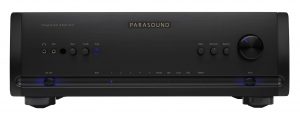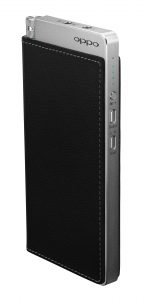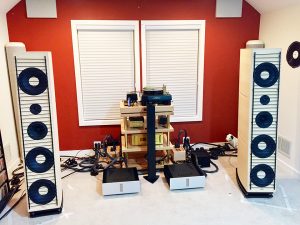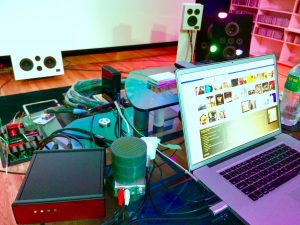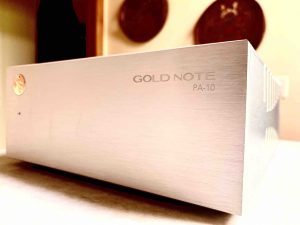I also might mention that Peter's Audio Note (UK) equipment is designed to perform superbly well in real-world home listening rooms, which is a boon to music lovers, and those—like me—who object to the idea of turning their homes into the equivalent of exotically damped and prepared dealer showroom.
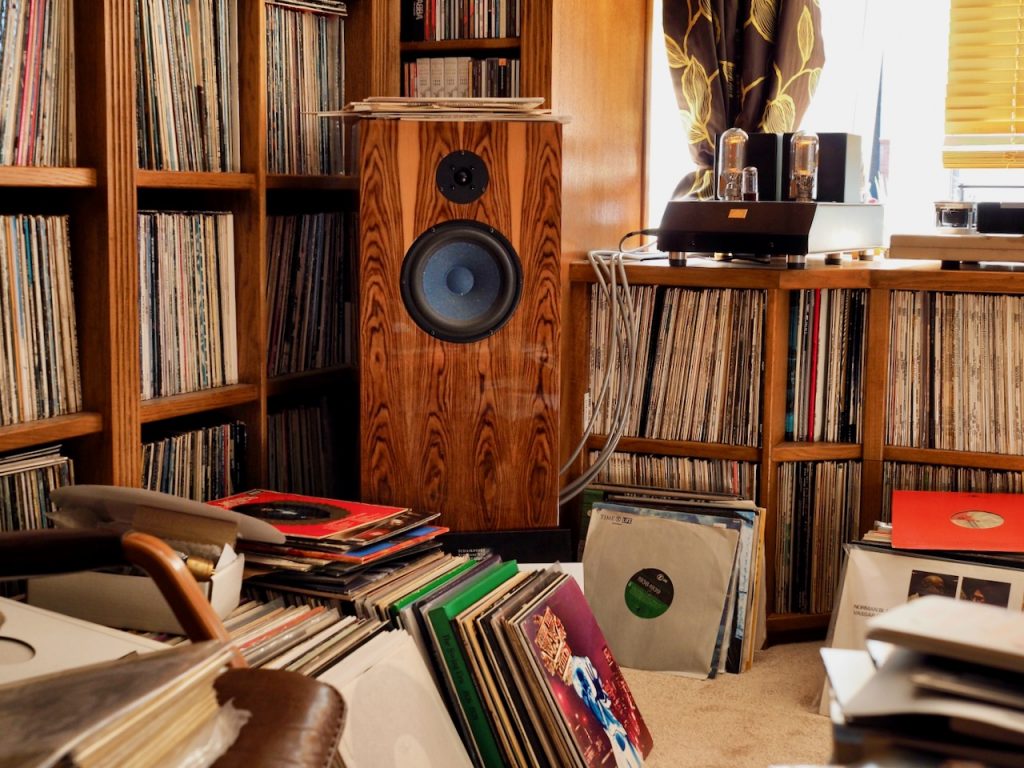
Take a look at the position of Peter's loudspeakers in the room corners, which are quite close to the walls in the room corners.
Peter's loudspeakers are designed to work optimally in room corner positions, which basically takes room boundary acoustic issues out of the equation.
Again, this is an insight gained from the peaks of research & development in audio history, as a number of early loudspeakers were optimized to work extremely well in room corners to remove the room as a factor that negatively affects fidelity, like my vintage Altec Corona 832A corner loudspeakers (below), for example.
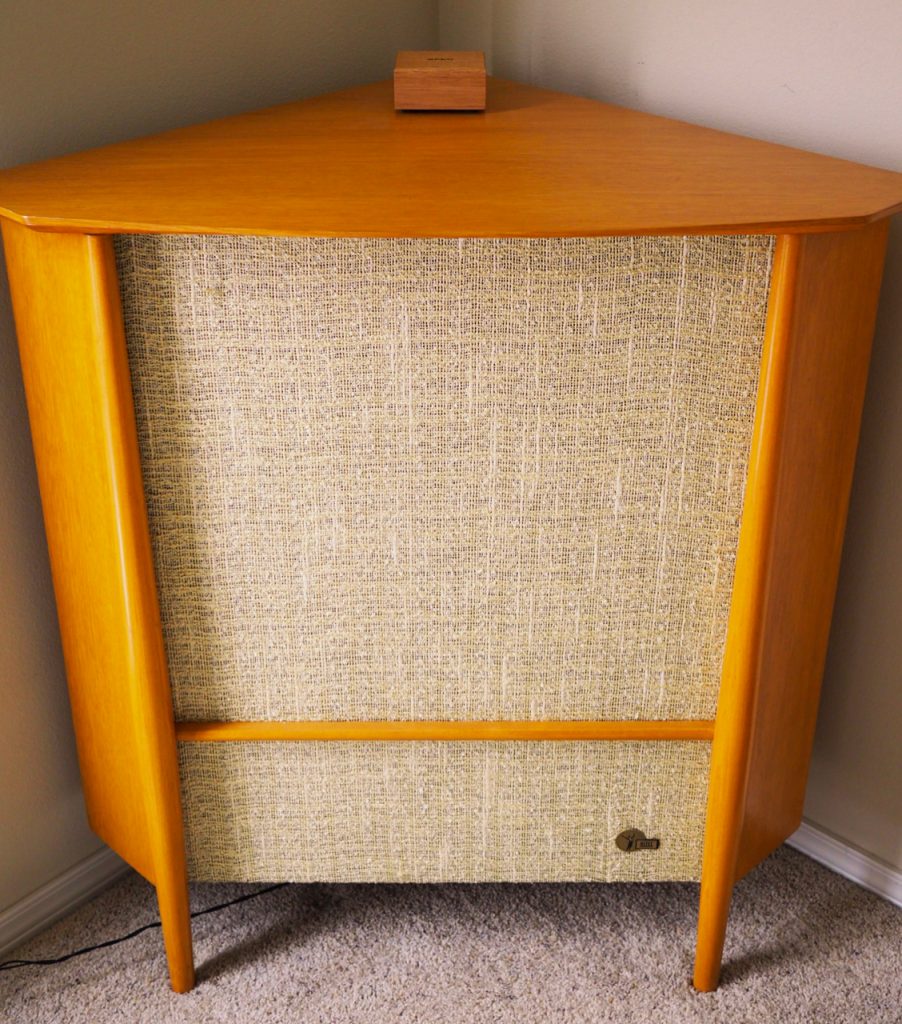
I might also mention I have used this principle in my smallish audio-visual room with my gigantic vintage Altec A5 Voice of the Theatre loudspeakers (photo below).
Some people say you can't use Altec A5's - that were designed to fill medium sized movie theaters with sound – in smaller rooms, claiming it just won't work.
That's a completely false assumption, of course. All I had to do to get truly stunning performance from my vintage Altec A5's in the corner positions of my smaller A-V room was to ditch the stock Altec crossovers, and then build adjustable Hiraga-inspired crossovers that were specifically modified to allow optimizing listening in smaller spaces.
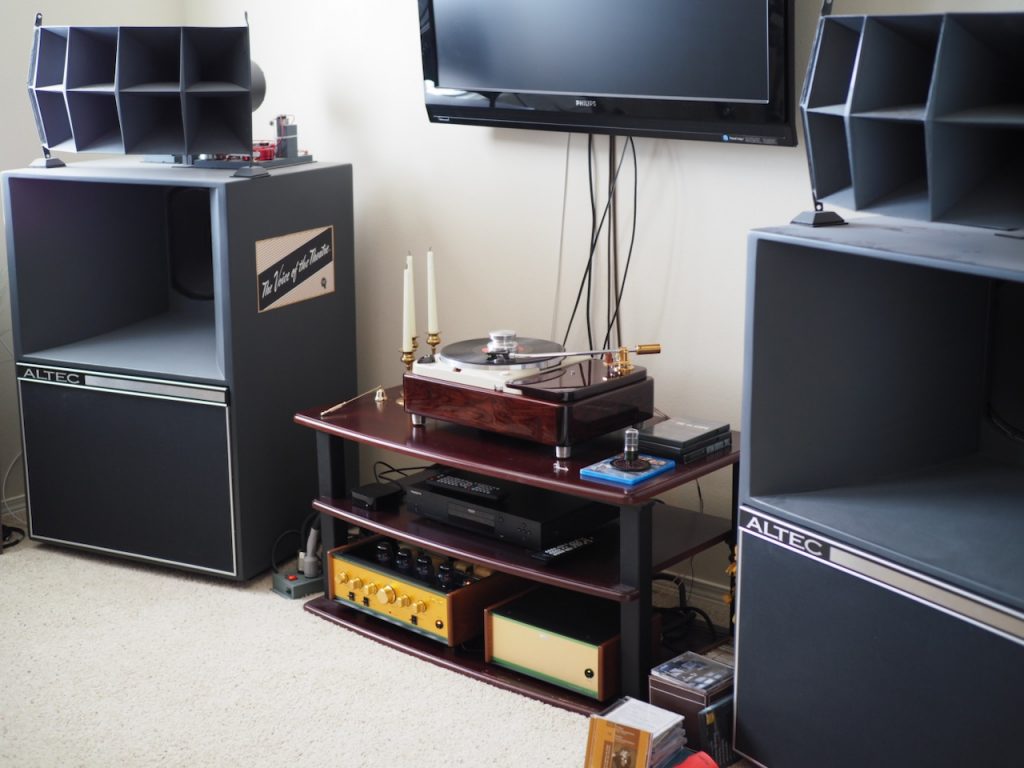
This allowed me to place the big Altec A5 into the room corners and adjust the high- and low-frequency drivers' integration properly for the smaller space.
The result is that my vintage Altec A5 based A-V system - even in my relatively small room—provides a sense of drama and scale that is rather remarkable, one that truly immerses the listener into the "feel" of a performance, creating a sense of drama, clarity, and emotional impact that makes music or film a truly wondrous experience.
I must say it is rather cool experiencing films with the mighty Altec A5 providing the sound, there is just something indescribably mesmerizing about their presentation of films that I find rather addicting.
In Peter's Audio Note (UK) loudspeaker designs he's already done all the work for you with voicing the crossovers and drivers, so all you have to do is place your Audio Note (UK) loudspeakers in the room's corners and sit back and enjoy listening to your music.
This is a great way to design loudspeakers for domestic music listening, in my opinion.
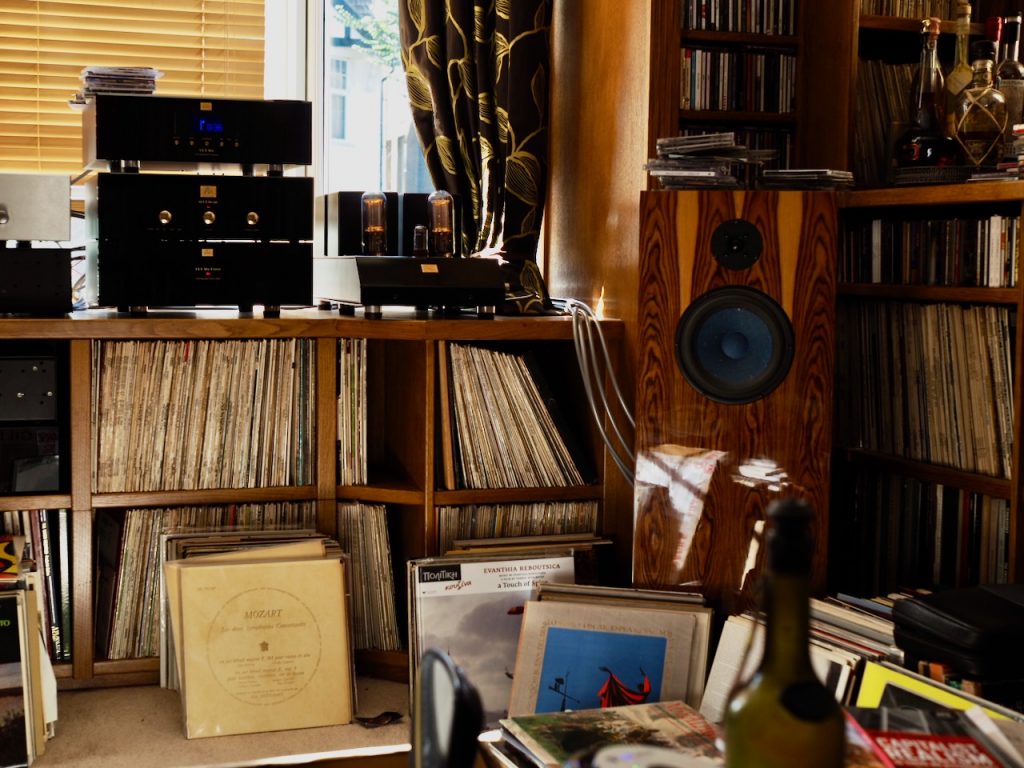
This is also why Peter's Audio Note (UK) systems perform so superbly in the generally "challenging" environment of hotel rooms at hifi shows, as they're designed to get the best out of the music while not being adversely affected by a room's boundaries, and the acoustic compromises they always have. The room is taken out of the equation.
One of the true highlights of our listening session for me - somewhat surprisingly given all the excellent vinyl—was listening to two 78rpm transfers to CD, one of which was unadulterated, and the other which was processed with "noise reducing" methods.
I was struck by two things, the first being how remarkably good a 78rpm transfer to CD can sound using purist methods, and secondly, it was astonishing to hear how much typical noise reduction techniques degraded the musicality and sonics of the music.
Instead of "noise reduction" methods, they should be referred to as "music destruction" methods, as the difference was profound.
Those 78rpm transfers to CD were made by Peter's late friend, Anatoly Markovich Likhnitsky, and they are truly remarkable.
Peter gave me a couple of CDs containing Anatoly's transfers to listen to while visiting Audio Note (UK) (photo below), and they are brilliant and exciting.
I have been immensely enjoying listening to Anatoly's transfers in my Altec A5 Voice of the Theatre loudspeakers based audio-visual system, and marveling at what he had accomplished.
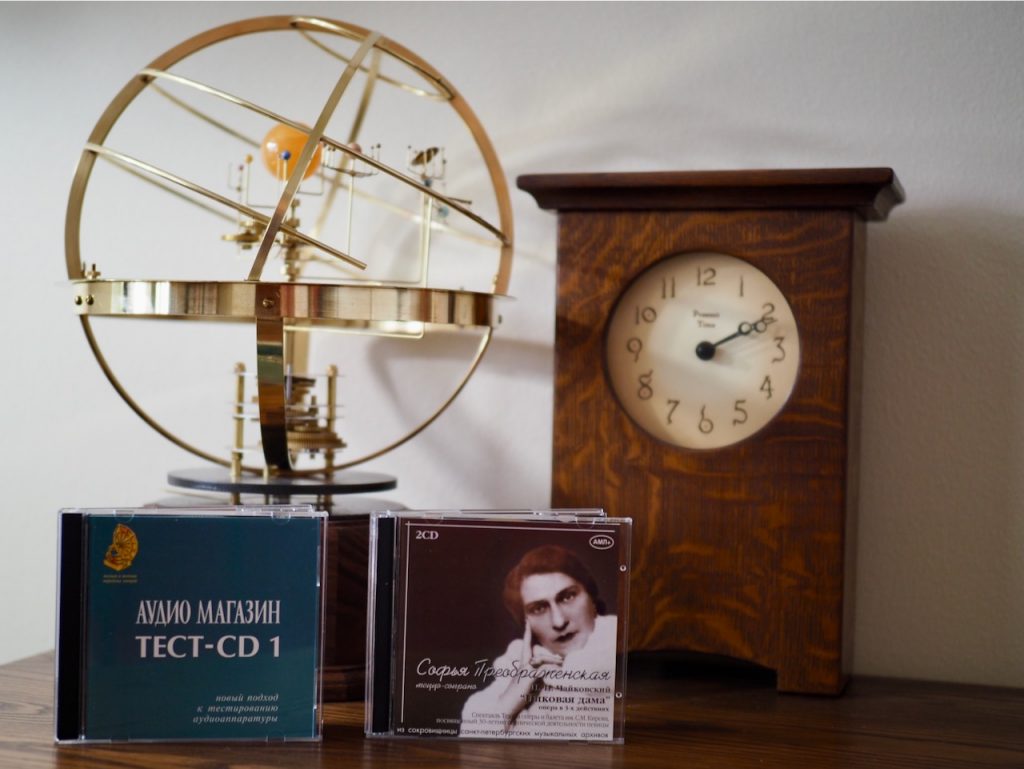
Peter just sent me several more of Anatoly's transfers to listen to (yes, I have become a fan of Anatoly's work), with one CD being from restored tapes, and the rest from 78s.
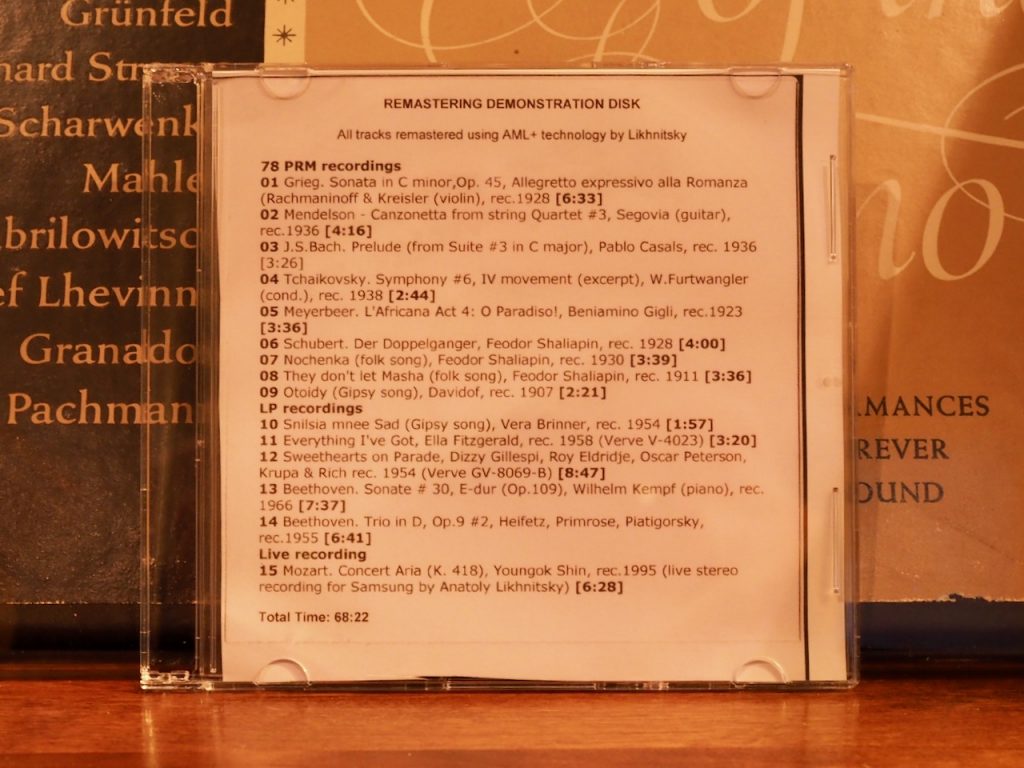
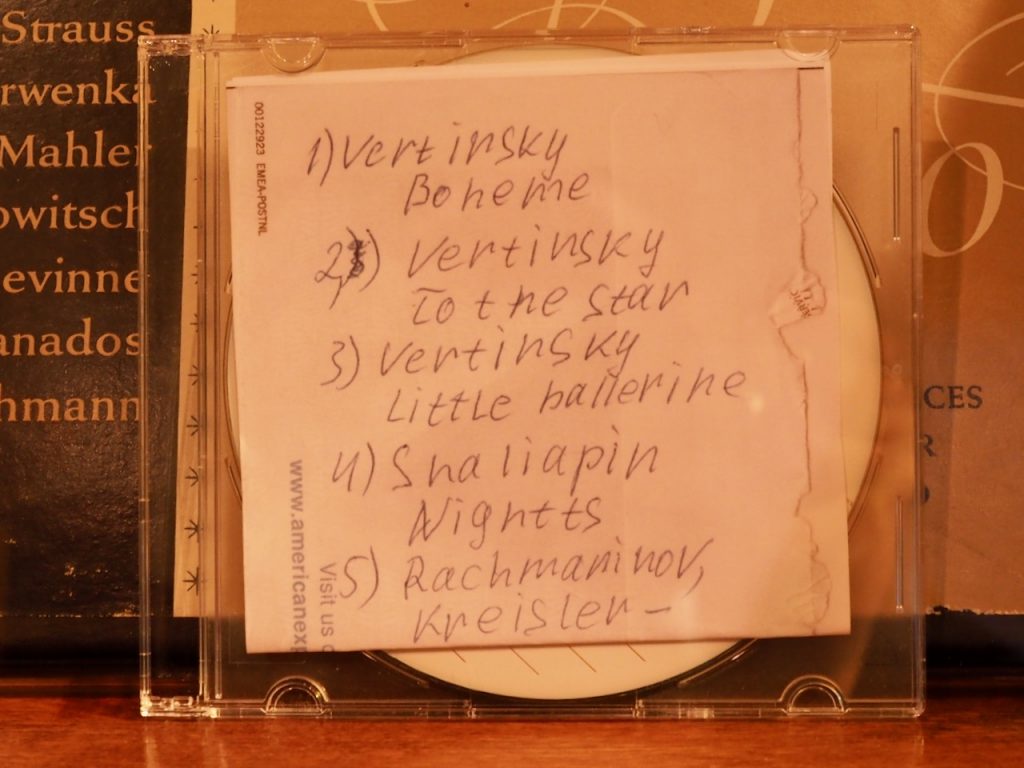
You can expect to read more about these at Jeff's Place in future posts, as I feel an overview of Peter Qvortrup's recommended Anatoly CDs coming on.
In particular, the CD pictured above with the handwritten track titles was amazing.
I told Peter, "I listened to the AML CD last night and it totally blew me away! Superb performances, and an uncanny fidelity that was like time travel that transported me back through a window in time to the event. Beautiful, and almost eerie, the way those transfers have the ability to make one feel like you are hearing through a window in time to be present at the original musical event. I was completely unprepared for what I heard, Really and truly, amazing."

Peter told me, "I promised you a bit of history about these transfers, and here is some of it from my perspective."
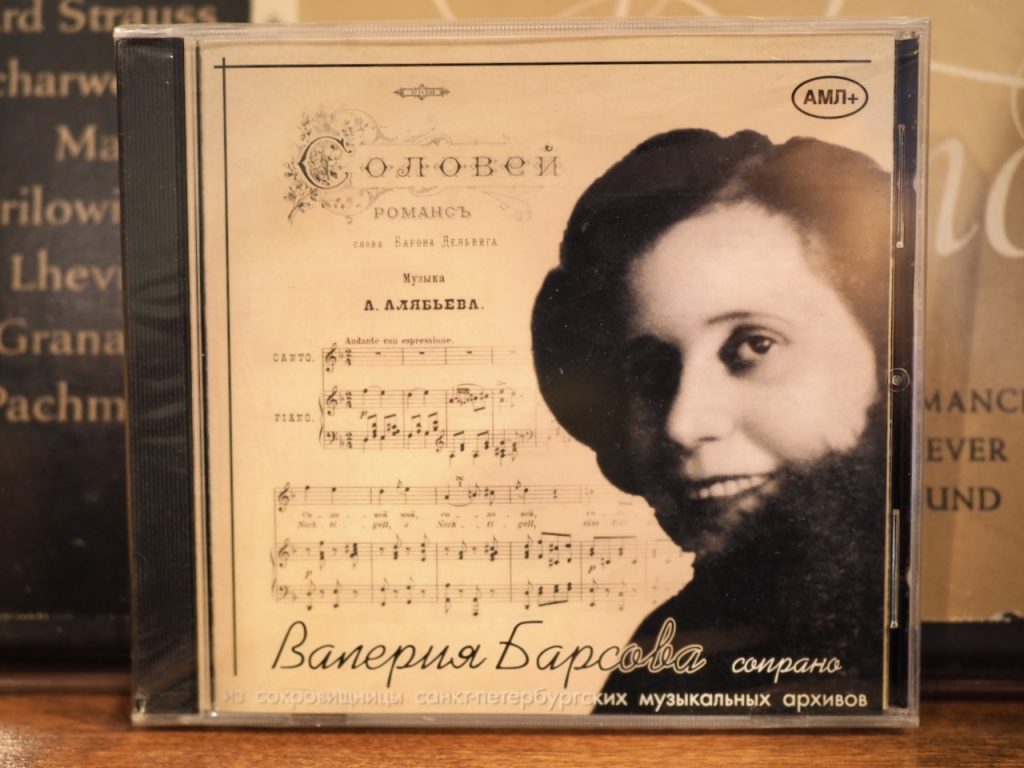
"Where to start … I met Anatoly Markovich Likhnitsky at the second Moscow show in 1993, I think, and spent a good deal of time talking with him about music, and about how the hi-fi industry had increasingly moved away from a real interest in music to offering products that were largely amusical in that they generally needed pristine recordings to produce a sound that was even moderately listenable."
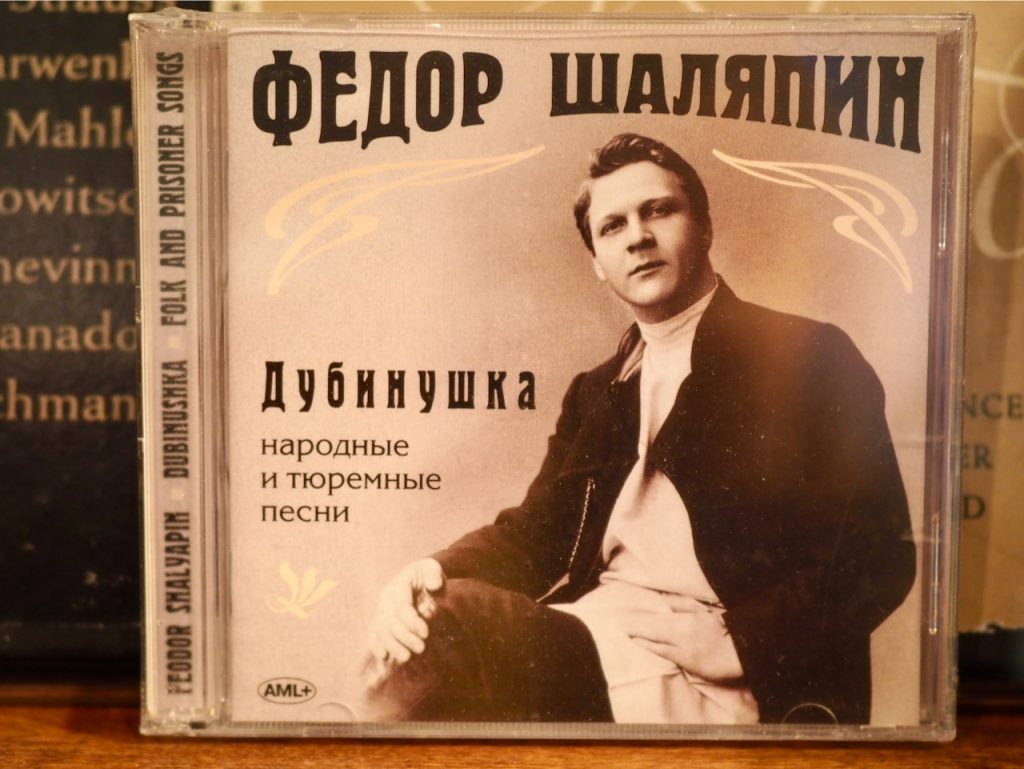
"Anatoly had spent his entire career at Melodiya as recording engineer, and in the latter years he worked on restoring early tapes and improving the quality of 78 transfers. Anatoly was of the opinion that 78s—especially— contained far more good information that they were generally credited with, and that the processes used to transfer the music from 78s to LP and CD were wholly inadequate. Anatoly said that he had developed a way of remastering 78s that gave hitherto unheard-of results in fidelity, and clearly showed that there is far more musical information in them than anyone had imagined." (Which I can attest to after hearing them, they are remarkable. - Jeff)
"I met with Anatoly and the editor of a leading hi-fi magazine again in 1994, and the idea came up for Audio Magazin to release a test disc. After much discussion it was decided to release a test disc which focused on showing musical performance quality rather than the usual cosmetically perfect recordings of vapid and largely meaningless music, the Test Disc 1 was born."
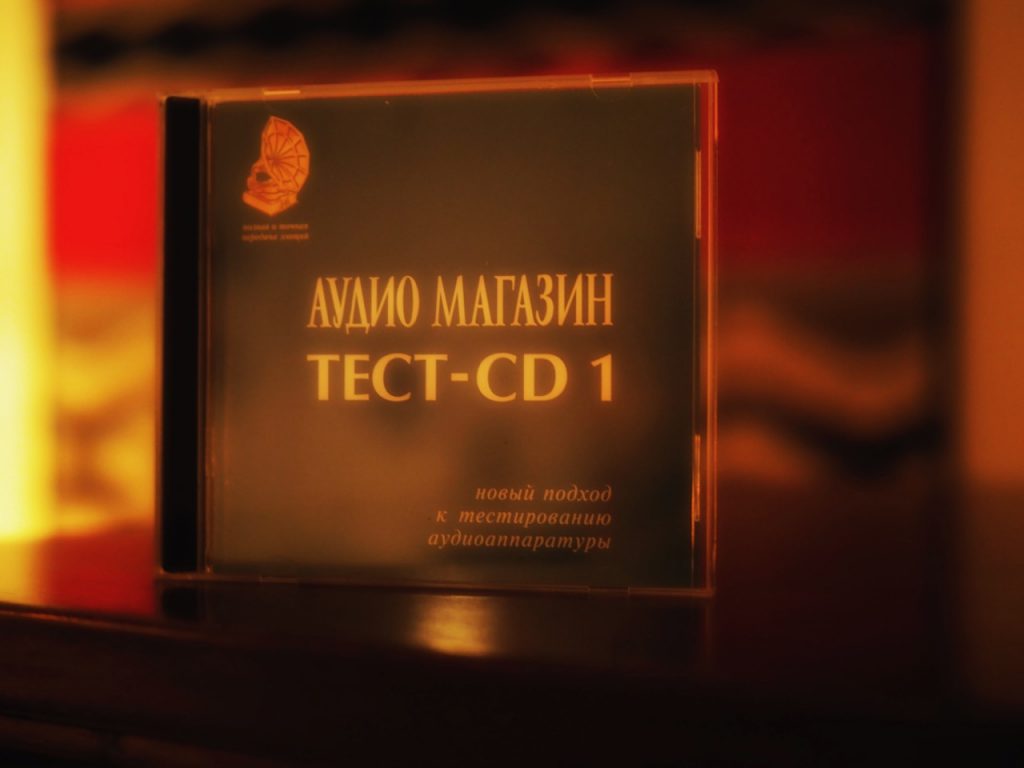
"I sponsored the release and in return received 500 copies which I have been giving to anyone who wanted to hear just how amazing these performances really are. Jeff, you got the last spare copy, ha ha!" (you can read more about the amazing Audio Magazin Test Disc 1 at Jeff's Place HERE).

Peter is looking at rereleasing the Audio Magazin Test Disc 1 "as a tribute to my friend Anatoly Likhnitsky who did the fabulous 78 transfers."
You can read more about the work of the great Anatoly Markovich Likhnitsky at Jeff's Place HERE.
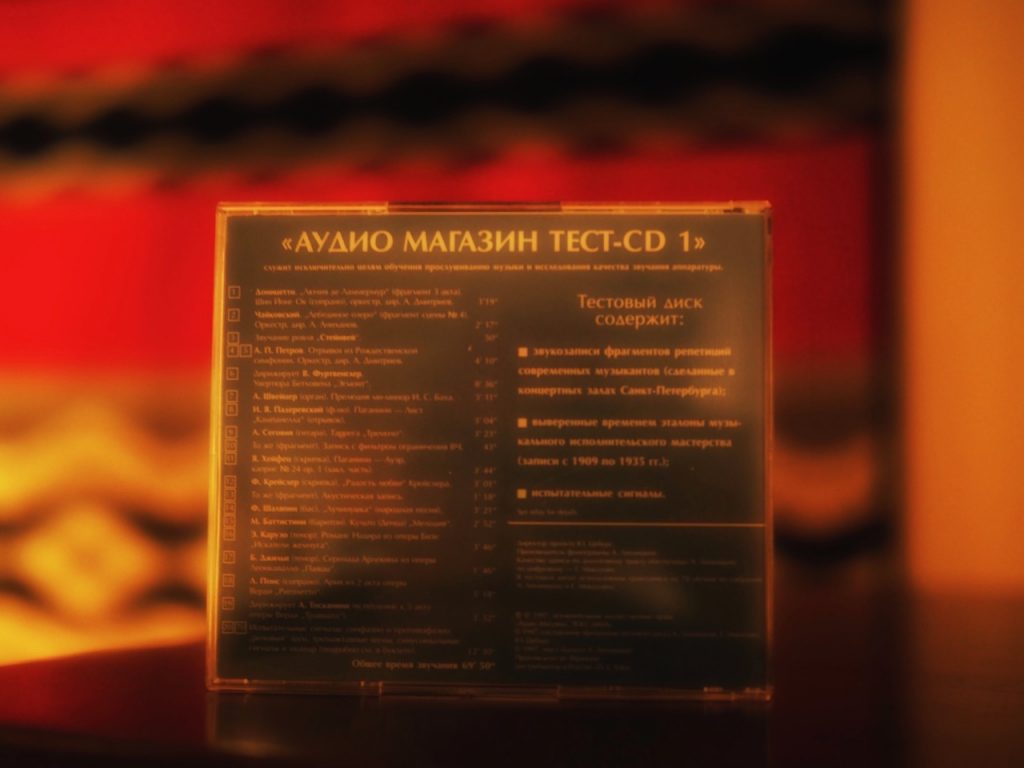
I'll keep you posted as I hear more about this, you won't want to miss out on this test CD if and when it becomes available again, it's truly impressive.
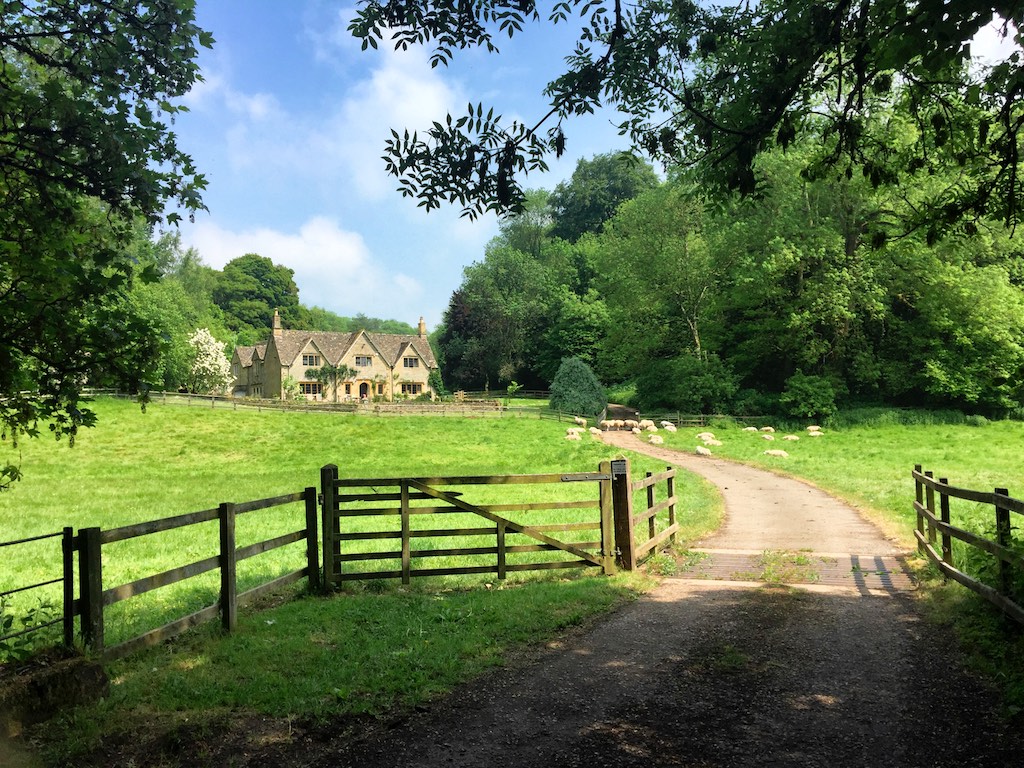
Another of the highlights of my visit was a road trip with Peter to the picturesque Cotswolds to personally deliver an Ongaku amplifier (if I remember the model correctly) to a customer vacationing with his family there.
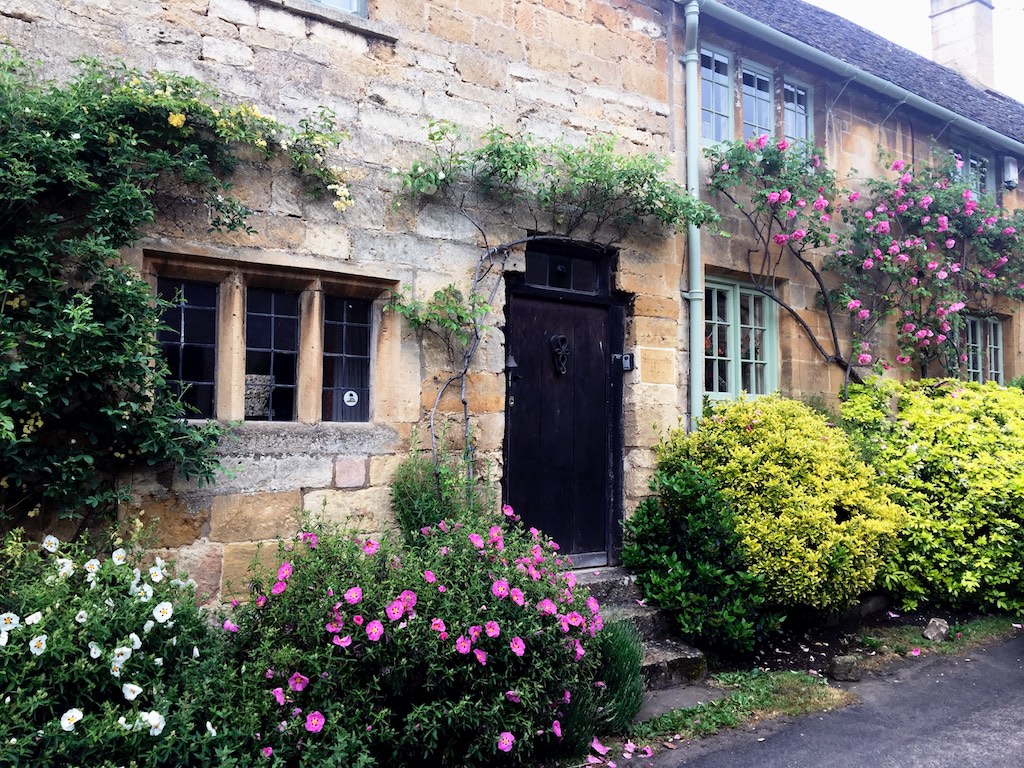
It was a pleasure to meet Peter's customer and his lovely family, they were absolutely delightful people.
It turns out they were from the Isle of Man, where my Grandfather's family originally hailed from. They were even familiar with some of Gramp's relations that still reside on the Isle of Man! It's a small world at times!

During the road trip, Peter and I talked about a wide range of fascinating topics. Peter is an engaging conversationalist, and we discussed music & audio, of course, but also Peter's fondness for notable Mercedes from history, and his impressive collection of them.
Peter studied economics at the university, and we spent quite a bit of time talking about economics, the effects of economic policy at the nation and global level, which I found to be truly illuminating (more HERE on this topic at Jeff's Place).
We touched upon politics, Brexit, his staff's impressive talents, his lovely family, and the rather remarkable business Peter has built up that is Audio Note (UK).
Peter, Lesley (wife), Emily (daughter), Daniel (son), and all the members of Peter's staff were particularly gracious towards me during my visit. Thank you to all for taking time out of your busy schedules to visit with me, much appreciated!
Peter and the broader Audio Note (UK) family and I had a couple of nice dinners out, and Daniel and his lovely wife Cintia gave me a wonderful tour of Brighton, England, which was a lot of fun to see.


For those in the States that have never been to Brighton, it is a delightful place that reminds me of a hybrid of Berkeley and Santa Cruz, California, with all the arts, culture, excellent dining, and whimsy that one could wish for.

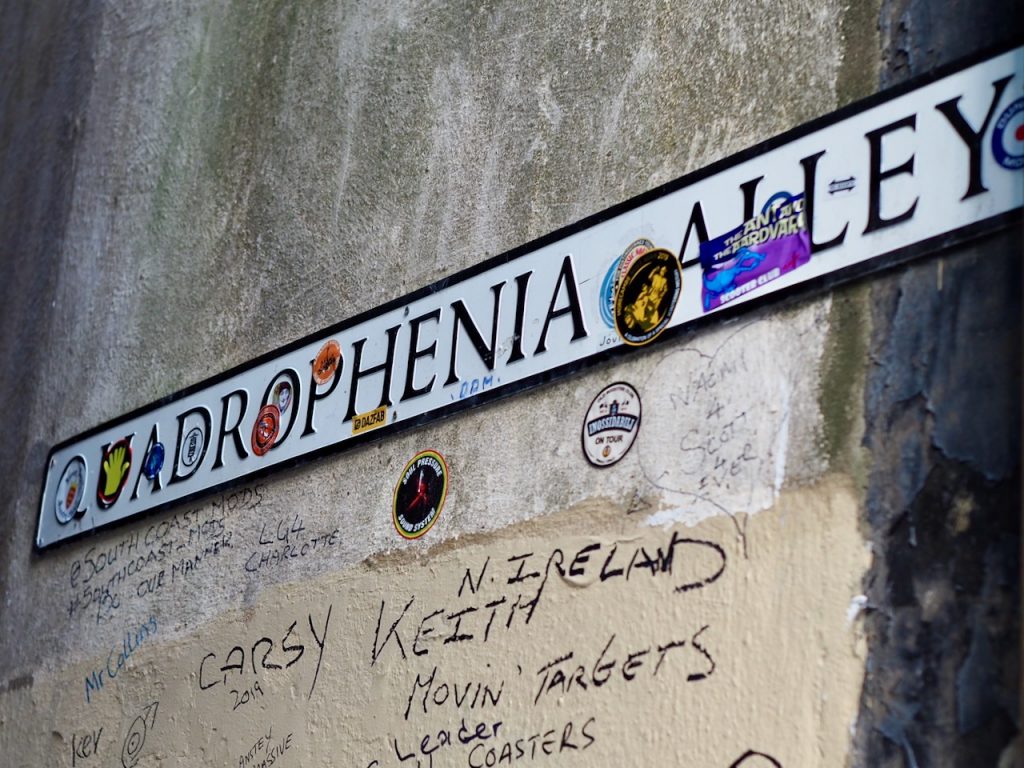
For more information about my visit to Audio Note (UK) headquarters, you can read all about it in my Jeff's Place posts HERE, HERE, HERE, and HERE.
Introduction to Audio Note (UK)
As is my custom for a Positive Feedback feature article, I really enjoy telling you about the people that are the company—in this case Peter Qvortrup—and how Audio Note (UK) came to be.
Unfortunately, due to the ongoing COVID-19 pandemic, I was not able to get the information from Peter in time for this feature article.
Hopefully, the COVID-19 pandemic will have abated by the time I write the feature article for the Audio Note (UK) CD 2.1x/II Red Book CD player, allowing Peter time to provide information for the "Introduction to Audio Note (UK)" section of that article.
The Audio Note (UK) Oto Phono SE Signature Integrated Amplifier
I find the Oto Phono SE Signature Integrated Amplifier to be a particularly interesting musical device. The Oto—Oto means "sound" in Japanese—has undergone several stages of evolutionary development over its many years of production.
The original Oto push-pull integrated amplifier existed prior to Andy Grove's arrival at Audio Note (UK). However, upon Andy's arrival he redesigned the Oto as a single-ended-pentode integrated amplifier in 1991, twenty-nine years ago now.
A few years ago, Andy went back and redesigned the original Oto push-pull integrated amplifier design as well, incorporating his current ideas of what a high-performance push-pull integrated amplifier should be.
An enduring design in an audio component always impresses me, and the Oto has legitimately become a classic design in integrated amplifiers, and its enduring popularity over its nearly thirty years of production endorses the essential rightness of Andy Grove's designs.
Today a customer looking at the Oto is offered a choice among several high-performance models, the push-pull pentode version (the Oto PP), a parallel single-ended-pentode version (Oto SE), and a parallel single-ended-pentode version which incorporates Audio Note (UK)'s most current concepts and components for achieving state-of-art performance that was released in 2016 (Oto SE Signature).
All of the Oto models are available as a line stage version, or as a version with a built-in valve phono stage (my choice), and the Oto SE Signature is also available in a "Silver" version with corresponding silver wire & components.
The version that is the focus of this article is the Oto Phono SE Signature ($6330 USD), and there's a number of aspects of this particular version of the Oto which pushed all my "ooh ahh" buttons as a high-performance audio enthusiast and music lover.

First of all, long time readers know that I am a big fan of integrated amplifiers because of their huge performance value for the dollars spent.
While the Oto Phono SE Signature at $6330 USD is not inexpensive in real-world terms, considering its overall performance, boutique build quality, and its included features, the Oto Phono SE Signature represents enormous value to the serious music lover or high-performance audio enthusiast at its price point.
Secondly, the Oto Phono SE Signature includes an internal vacuum tube phono section, which provides even more value and allure to a vinyl lover like myself (it's also a pretty special vacuum tube phono section, which I'll tell you more about a bit later).
Thirdly, the Oto Phono SE Signature is an EL84 amplifier, and I have a particular fondness for EL84 amplifiers. The EL84 is a vastly under-appreciated vacuum tube that can sound fantastic, with the added benefit of being very cost effective and inexpensive to maintain over the long haul.
The EL84 vacuum tube is not only used in audio amplifiers to play back recorded music, but notably it is also used in guitar amplifiers to make music, like the legendary Vox AC30/AC15 guitar amplifiers, for example, and has also become popular among boutique amp builders in both the audio and guitar sectors.
The EL84 is a great tube on its own merits, and when coupled with the fact that it is a readily available and affordable vacuum tube, it makes the EL84 an incredible value for guitarists, music lovers, and audiophiles alike.
Fourth, the Oto Phono SE Signature is a parallel single-ended-pentode amplifier, and I love the way EL84 single-ended-pentode amplifiers play music.
EL84 single-ended-pentode amplifiers sound so live, real, visceral, engaging, and emotionally involving on my various vintage Altec loudspeakers.
I've enjoyed using an EL84 single-ended-pentode integrated amplifier for a decade—the now discontinued spartan Almarro A205A—and it always impresses me with its superb performance.
Oto Phono SE Signature Integrated Amplifier Features
Starting with the front of the Oto Phono SE Signature, let's do a walk-about of it to check out its features.
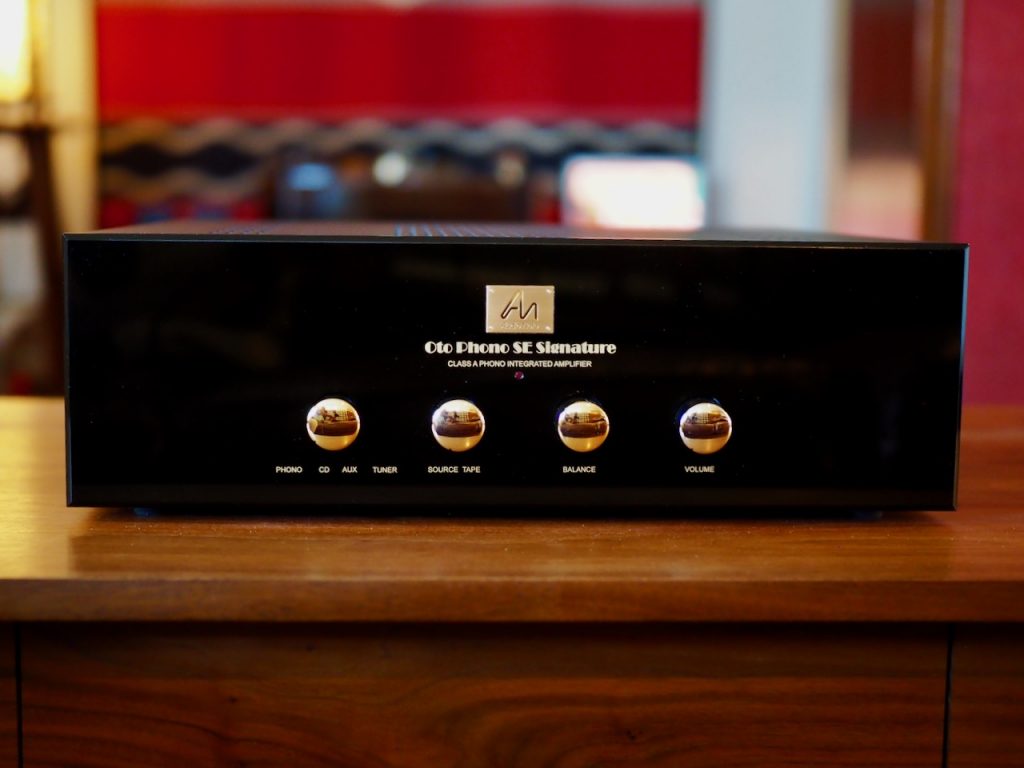
There are four selector knobs that control its operation on the front panel. Left to right, the first knob is for selecting the source (phono, CD, auxiliary, tuner), the second knob is labeled "source / tape" and allows you to switch between the selected source input and the output of a recording device, the third knob is a balance control, and the fourth knob is the volume control.
The "source / tape" feature is probably not something I will use, but I know many of you really value this feature.
For example, while blogging about my real-time impressions of the Audio Note (UK) Oto Phono SE Signature integrated amplifier over time, I got a nice message from mastering engineer—and man of many talents, Steve Hoffman—that said, "I use an Audio Note ((UK)) Ltd Oto Phono SE Signature in my studio. It's amazing, especially for the money, a really nice EL-84 unit that does it all." and "The Oto has everything I need in the studio, phono section, tape/EQ loop, everything."
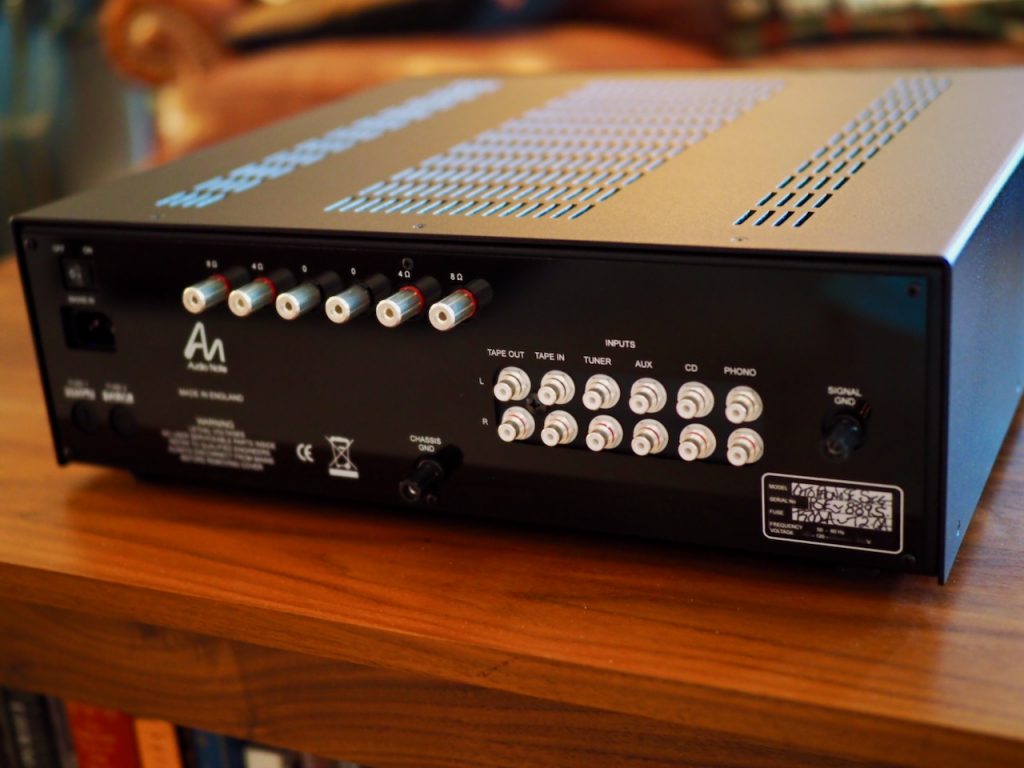
Around back of the Oto Phono SE Signature—left to right—are the on/off switch, an IEC AC inlet, binding posts for speaker cables (there are binding posts for both 8- and 4-Ohm connections), a chassis ground connection (for source components that have a separate ground terminal), RCA inputs (tape out, tape in, tuner, auxiliary, CD, and phono), and a signal ground connection for the phono stage.
Oto Phono SE Signature Integrated Amplifier Design – Andy Grove
The latest incarnation of Andy Grove's Oto Phono SE design—the "Signature"—was released in 2016, which incorporated Audio Note (UK)'s most current concepts and components for achieving state-of-art performance.
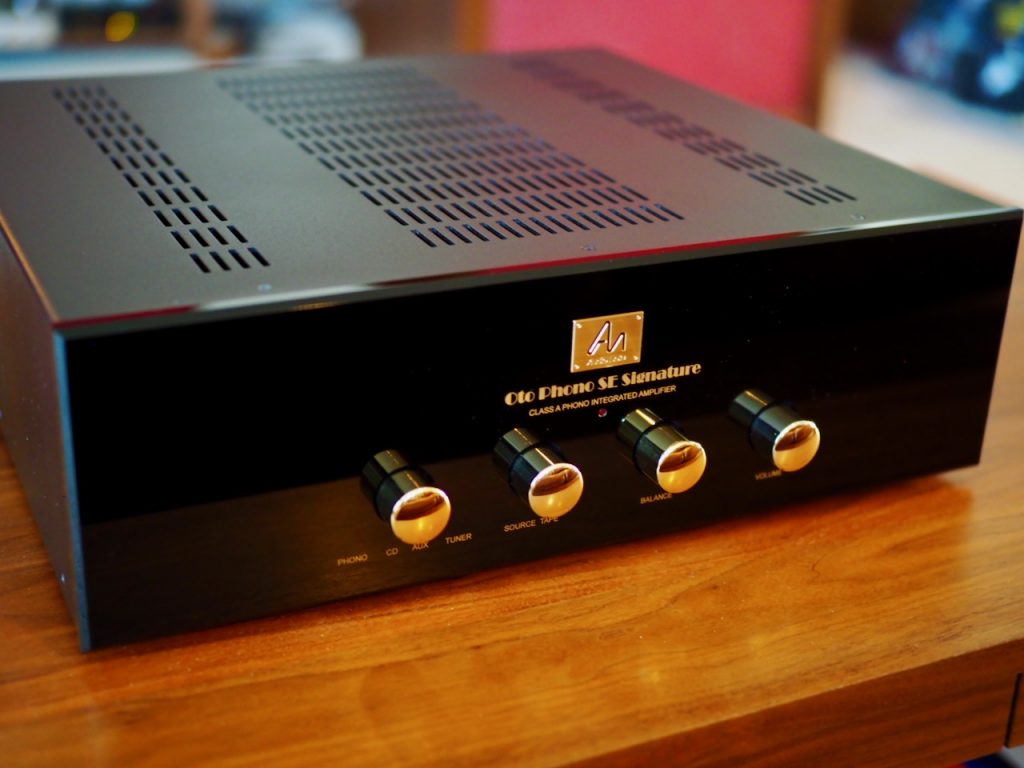
I like Andy, it was a true pleasure to meet him while visiting Audio Note (UK) earlier this year, and as you will read about in a moment, Andy's quite the character!

I asked Andy if he would tell us a little more about his design of the Oto Phono SE Signature integrated amplifier, both in the circuit, the components used, and a little background about the "why" of his choices.
Andy told me, "As I said, the Oto SE was my first properly commercial design, I was 23 at the time, and a bit naive and arrogant with it, not the graceful kung-fu master you see before you nowadays."
"I'd been making audio stuff since I was a young teenager, much to the entertainment of my parents and neighbors. My other passions included getting in fights, heavy metal music, electric guitar, air rifles, pyrotechnics, and hot air balloons that had a habit of catching on fire and crash-landing in inappropriate places, so I was a popular young lad—or so it seemed, given the amount of people who came around asking to see me."
"I met Peter because I'd built a set of 211 amps, and I wanted him to hear them, and then, or shortly afterwards, he asked me to design a single-ended EL84 amplifier—which I did."
"The concept I had was, if possible, to use only a single stage of gain, and then to the output valves. There is one thing you learn quickly, and that's simplicity sounds good, even if the route to get there is complex. Furthermore, with only one gain stage, amplifier stability was more or less guaranteed, and that has a strong effect on how an amplifier sounds as well."
"The Oto was more like something that happened; I looked at various different options, and the ECC83 / 12AX7 to EL84s way of doing it had a golden light shining on it through a crack in the clouds, there was no other choice really, so I can't tell you I meditated for days, or conducted a lot of research. As soon as I drew the schematic I knew it would work."
"The Oto SE, or rather the power amp part of it, was the first (successful) project I did for Peter and Audio Note, roughly 29 years ago now (1991). The formula remained virtually unchanged, with a few tweaks and updates here and there, until, just recently (2016), we created the Signature version of it, which incorporates our most current concepts and components."
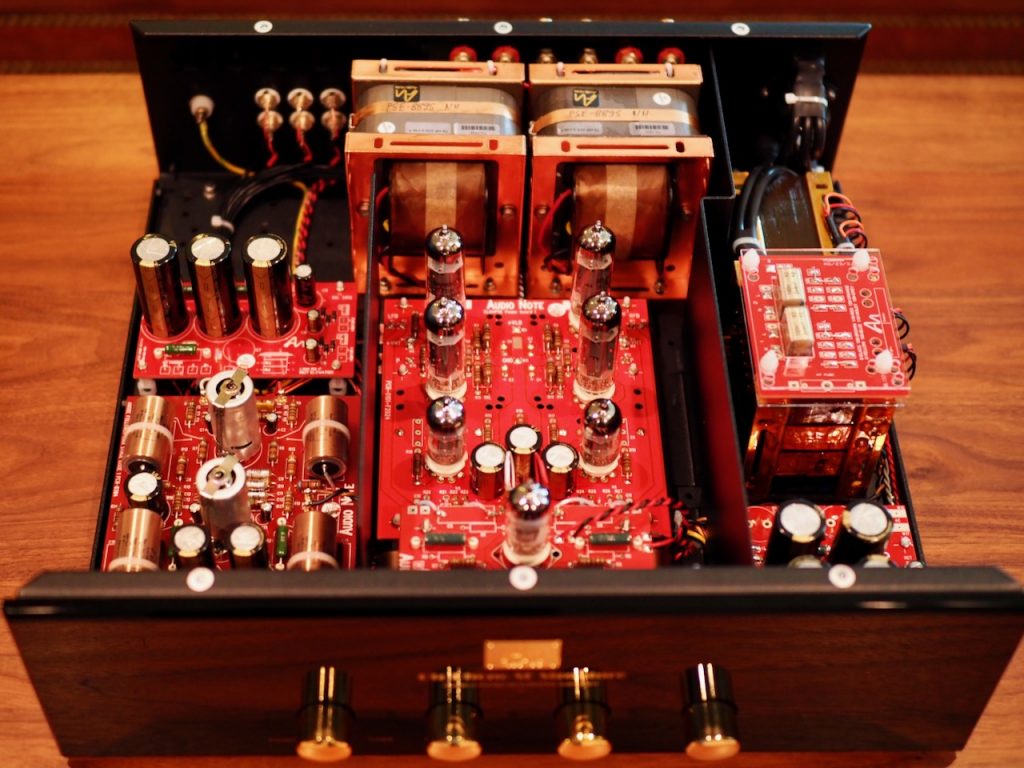
"In the Oto SE's engine room are two pairs of EL84 power pentodes, one pair per channel (four pieces in total), in parallel single-ended mode. Each pair is driven by an ECC83 (12AX7) double triode in SRPP (Shunt Regulated Push Pull) configuration in which one triode is the amplifier, and the other an active load. The EL84 power is transferred to the speaker load by a large output transformer, and there is a moderate amount of feedback taken from the secondary to provide adequate damping to the speaker." (in the center of the above photo – Jeff)
The Oto Phono SE Signature integrated amplifier provides 10 watts per channel of parallel singled-ended-pentode EL84 power, making the Oto a true powerhouse of an amplifier with my sensitive Altec loudspeakers.
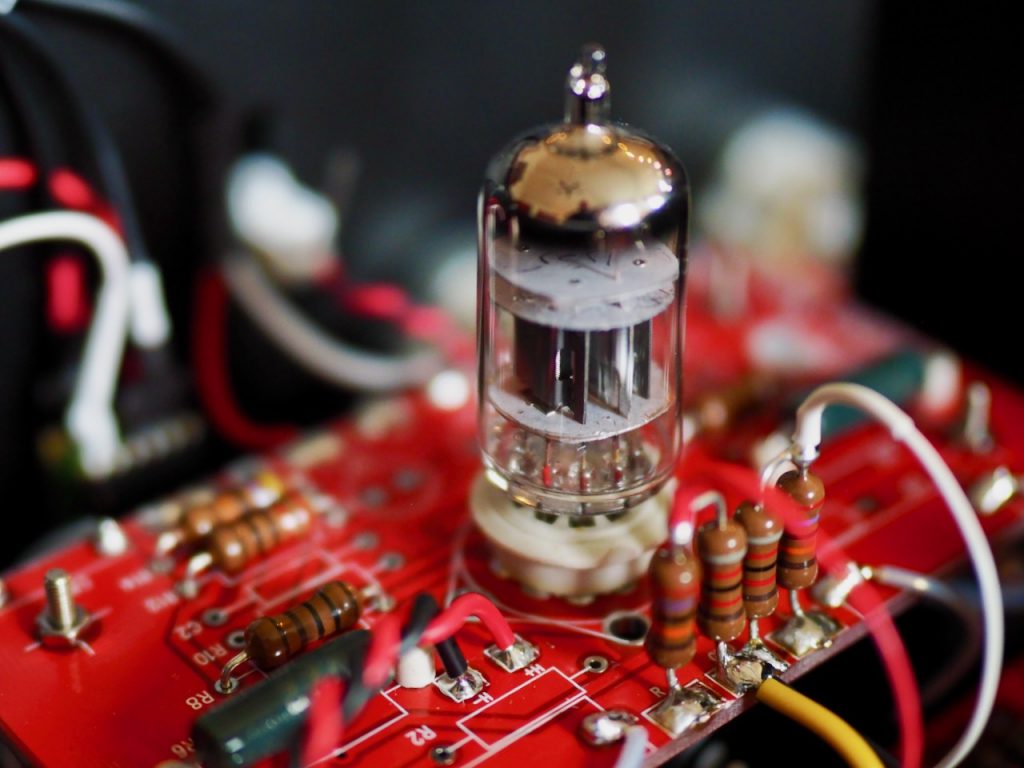
"The phono version has an additional line stage, using an ECC82 (12AU7), and the phono stage itself, which is comprised of an ECC83 and an ECC88 (6DJ8), the phono stage is zero feedback, with a RC passive RIAA EQ network." (line stage in the above photo, phono stage in the below photos – Jeff)
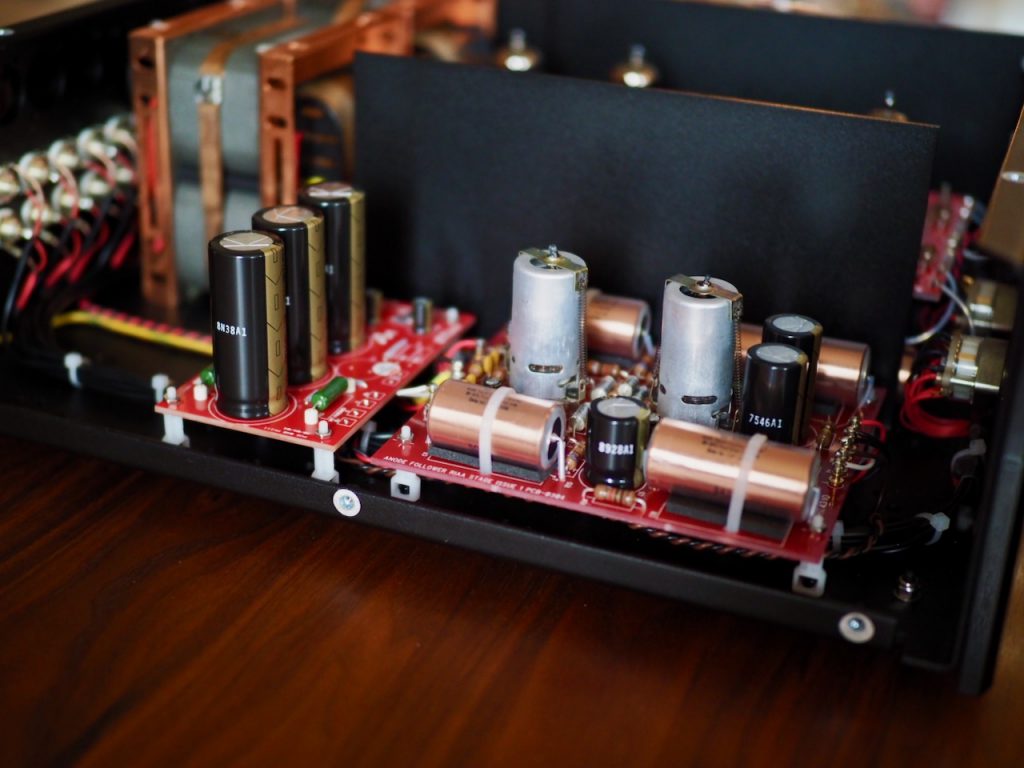
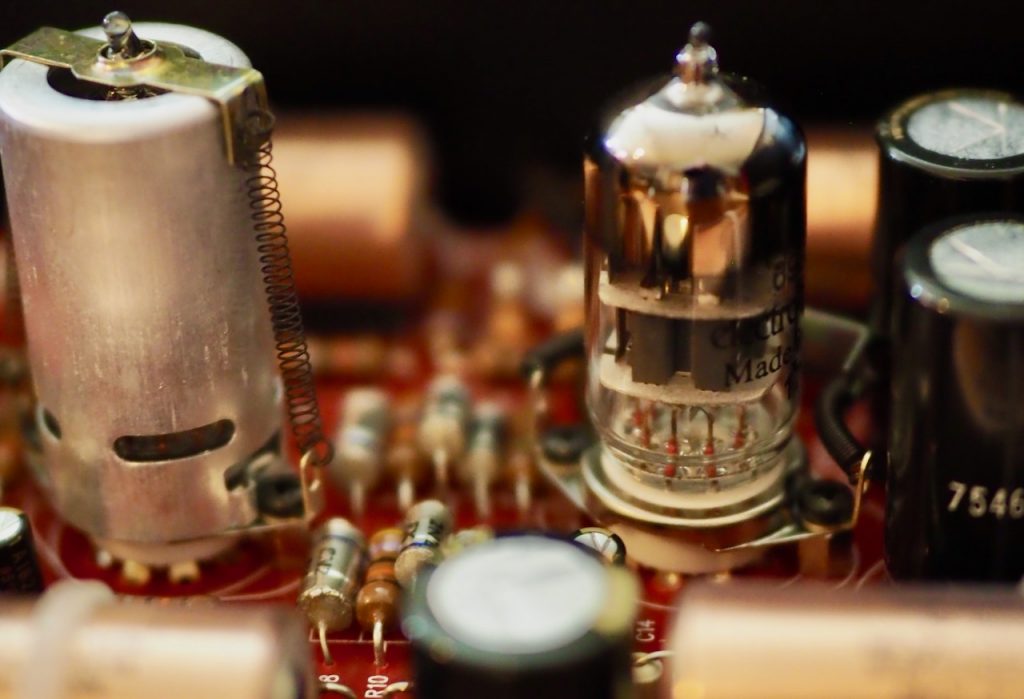
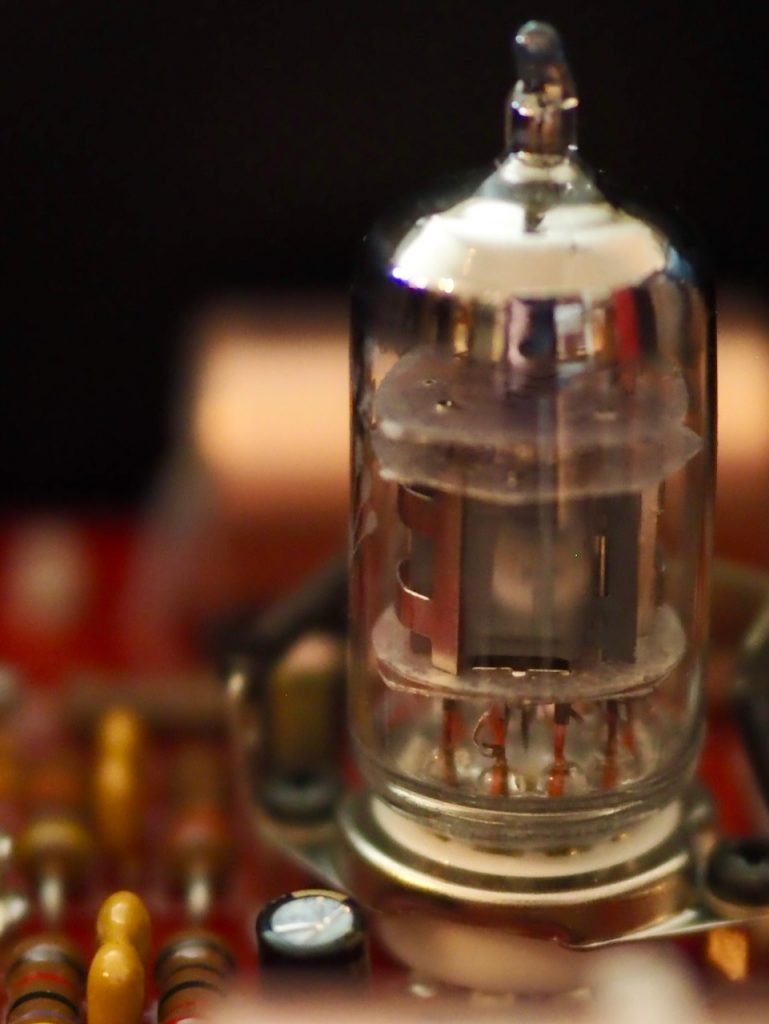
"The power supply is fairly straightforward, with rectification performed by silicon diodes, with conventional RC filtration."
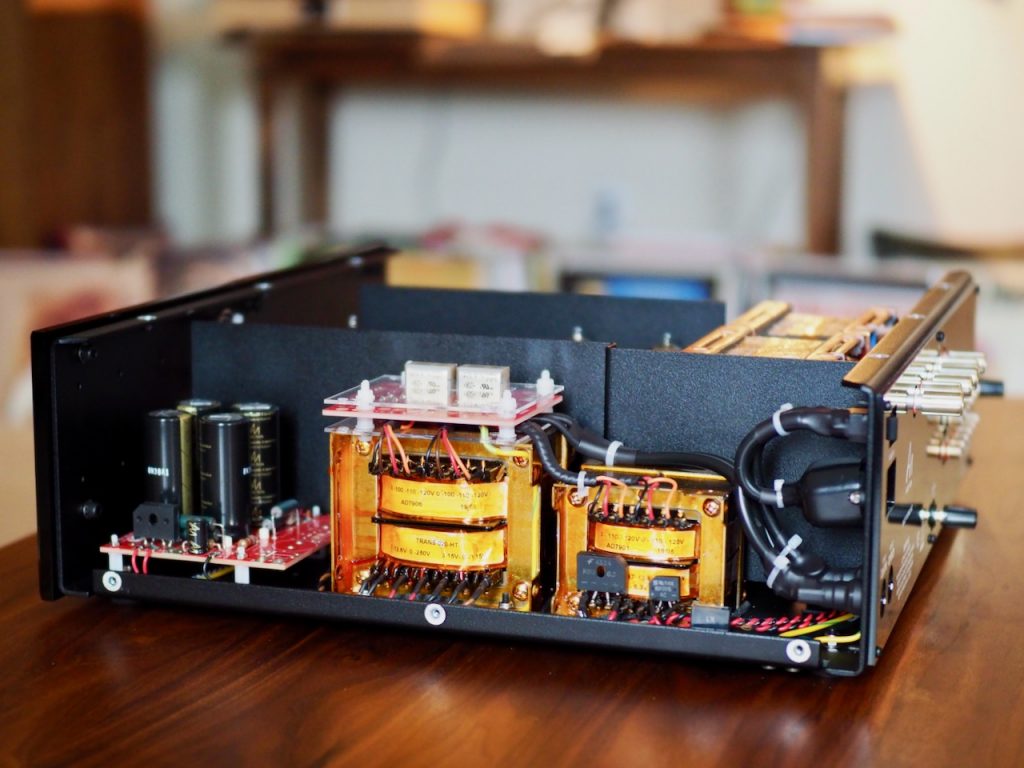
That's the Oto's power supply in the photo above. The transformer on the left is the mains transformer for the amplifier, the one on the right is the dedicated mains transformer for the phono stage.
"The 'plain vanilla' version uses our well-known combination of Beyschlag resistors, Rubycon, BC and similar 'standard' type electrolytic capacitors, ERO mylar coupling capacitors, and the transformers are cored with silicon steel laminations."
"The Signature version is the same architecture, but with a selection of tantalum resistors, Kaisei capacitors, and an output transformer which is cored with HiB silicon steel C-cores and are specially impregnated and coated." (photo below – Jeff)
Many thanks to Andy for a nice description of the Audio Note (UK) Oto Phono SE Signature integrated amplifier.
In addition to what Andy has shared with us, I'd like to delve a little deeper into the transformers, resisters, and capacitors used in the Audio Note (UK) Oto Phono SE Signature integrated amplifier, as they are all built in-house by Audio Note (UK), like the transformers, or custom built to Audio Note (UK)'s specifications by other parties.
On the Audio Note (UK) website page for transformers it says, "The output transformer is, without a doubt, the single most important component in any high-quality valve amplifier. It is impossible to make a truly exceptional amplifier without investing in the best possible output transformer, which in turn must be correctly designed for the circuit and valves being used."










